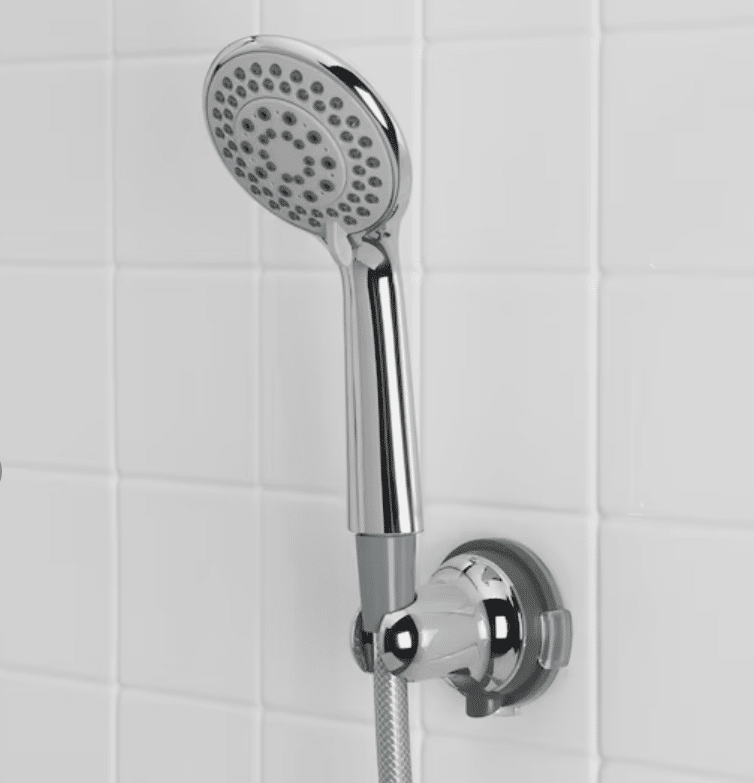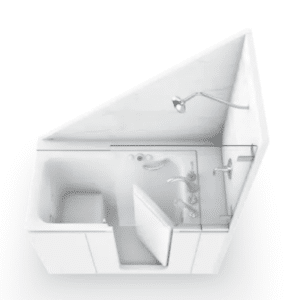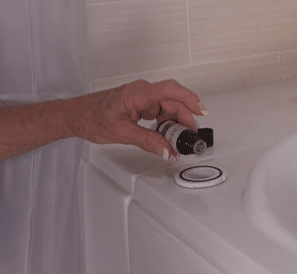Kohler offers its shower package as an optional add-on to a Kohler walk-in tub, which converts your existing bathing space into a safe and accessible walk-in tub and shower. The shower package adds a wall-mounted showerhead and bath screen—a clear partial enclosure—to its original walk-in tub design to create a bath any family member can use. Kohler walk-in tubs are specifically and fashionably tailored to your bathroom and personal needs, combining in-home consultations, sleek ADA-compliant designs, a lifetime limited warranty, and one of the lowest threshold heights on this list (3 inches). For those reasons, Kohler is our clear choice for “Editor’s Pick.”
The 4 Best Walk-In Tub-Shower Combinations in 2025
Key Takeaways
- Walk-in tub and shower combinations offer a safe way to bathe for people with mobility problems and/or at risk of falling, while also offering a standing shower option.
- The price of walk-in bath-shower combos ranges from $3,000–$10,000 before installation, which is at least $1,000 higher than walk-in tubs alone.
- Medicare and private insurance don’t cover the cost of walk-in tubs, but you can find discounts, apply to national and/or local programs, and opt to finance to help pay for them.
If you have difficulty balancing, limited motion, or a history of falls, a walk-in tub is a home modification that can help you age in place safely and independently. Many walk-in tubs are designed for seated bathing with hand-held showers, but there are some brands that offer overhead showers for those who want the option of standing.
Walk-in tub and shower combinations offer the low-threshold entry of a walk-in tub with the convenience of an overhead shower. This gives you the option to sit or stand while also accommodating other household members who prefer a standing shower. Many walk-in tub and shower combos also comply with the Americans with Disabilities Act (ADA).
Our Reviews Team identified the best walk-in tubs, but which brands in the industry offer the best walk-in bathtub and shower combos? Keep reading for our expert-chosen picks.
Best walk-in tub-shower combinations at a glance
- Editor’s Pick Walk-in Tub Shower Combo: Kohler
- Most Affordable Walk-in Tub with Shower: Ella’s Bubbles
- Most Features in a Walk-in Tub Shower Combo: Safe Step
- Best Large Walk-in Tub with Shower: Boca
Best walk-in tub-shower combinations in 2025
Comparison of best walk-in tub-shower combos
| Cost | $2,500–$15,000 | $4,348–$10,840 (with shower column) | In-home estimate required | $8,000–$14,000 |
| Tub type | Jetted | Soaker or jetted | Jetted | Soaker or jetted |
| Threshold height (inches) | 3 | 4–7 | 4 | 2 |
| Safety features | Grab bar | Grab bar, slip-resistant floors, optional scald protection | Grab bar, slip-resistant floors, ozone cleaning system, scald protection | Grab bar, slip-resistant floors, ozone cleaning system, scald protection |
| Warranty | Limited Lifetime | Limited Lifetime | Limited Lifetime | Limited Lifetime |
Table 1 Comparison of best walk-in tub-shower combos, as of 2025
What is a walk-in tub-shower combination?
A walk-in tub-shower combination merges the safety of a walk-in tub with the convenience of an overhead shower. They range in price from $3,000–$10,000.
Walk-in tubs are a type of bathroom modification that creates a safe passage into and out of the tub. A hinge door opens a pathway into the tub, reducing the tub’s threshold to 2–7 inches. A walk-in tub is a good option if you’re concerned about safety in the bathroom, especially if you have mobility limitations and/or trouble balancing when stepping over a tub’s typical 14- to 16-inch threshold.
If you’re switching to a walk-in tub, consider that some walk-in tubs do not offer an overhead shower. Most walk-in tubs have a hand-held showerhead installed next to the faucet, but some don’t have a showerhead option at all. If you want an overhead shower, you may need to shop specifically for a walk-in tub-shower combination, where the showerhead is installed on a column or wall. If you don’t have the space or budget for an overhead shower, you may be able to find a creative cost-effective solution, like installing a wall bracket so you can place the hand-held showerhead on the wall when you want to stand up in the shower.
Pros and cons of walk-in tub-shower combinations
What to consider when shopping for a walk-in tub and shower
When shopping for a walk-in tub and shower combination, consider a few options and features that can impact your post-purchase experience with your tub.
Tub size and shape
Size matters. Make sure you pick the right sized tub to accommodate you and fit your home. When our Reviews Team evaluated brands for best walk-in tub-shower combination, we chose brands with a range of tub, door, and seat sizes to fit most people’s needs. Tubs that are less than 60 inches long and 30 inches wide are not ADA compliant and may not be the most accessible option. Excessively large tubs may take up most of the floor space, cluttering your bathroom and decreasing accessible areas.
The best way to pick the right size and shape is by arranging for an in-home assessment from the walk-in tub brand of your choice. Our Reviews Team values the free in-home assessments offered by many brands because a walk-in tub professional can evaluate your home and needs, take accurate measurements, and recommend the best solution, so you’re only paying for what you need. If you opt for a brand that does not offer free in-home assessments, look for online guidance, like the Ella’s Bubbles measurement guide. You can also search for physical or occupational therapists who are qualified to evaluate you and your home through organizations like the Home Modification Occupational Therapy Alliance. You may be able to ask your doctor to write a prescription for a home evaluation, so your insurance is more likely to cover the cost. Home safety evaluations or assessments by occupational or physical therapists are very helpful in identifying a range of changes or modifications that can be made to your home to help you safely age in place.
Safety features
A home evaluation is also useful in choosing which safety features are most important to you. ADA-compliant walk-in tubs have non-slip floors, seats, grab bars, and hand-held showerheads as basic accessibility requirements. But there may be more safety features to consider.
If you have low sensation in your feet and legs due to poor nerve conduction from conditions like diabetes, you may need anti-scald features that block temperatures from exceeding certain thresholds, like the 100 degree Fahrenheit limit (with an override option) Boca offers for its tubs. This ensures water temperatures don’t accidentally exceed scalding levels (around 120 degrees Fahrenheit) while you’re seated in a filling tub.
If you’re worried about tripping while entering or exiting your tub, you may want to opt for a low-threshold tub, like the Boca two-inch barrier. You may also want to consider adding more grab bars where you need them. To help prevent slips while navigating your tub, especially if you’re using the overhead shower while standing, you can add additional non-slip surfaces.
“Non-slip floor mats will help when placed on the bottom of the tub and just outside the tub, since these tend to be very slippery and can place someone at risk of falling,” said Brittany Ferri, an occupational therapist based in Rochester, New York.
Showerhead options
When choosing a showerhead, there are several options to consider depending on your circumstances.
Hand-held showerhead
A hand-held showerhead allows you to easily move the direction of water flow when using the shower or cleaning the shower and tub area. The showerhead rests on a wall bracket that is attached to the shower wall.
Rain showerhead
A rain showerhead is a type of overhead fixture that is significantly larger than a traditional fixed or hand-held showerhead. It can be mounted on a sidewall, using a straight- or gooseneck-arm or can be mounted directly overhead. The water falls straight down from the showerhead (rather than at an angle), making it feel like you’re standing under heavy rainfall. This can have benefits of full body relaxation and is often more visually appealing than other fixed styles.
Gooseneck showerarm
Gooseneck showerarms are known for their unique curvature that allows water from the showerhead to flow down, rather than at an angle. The gooseneck showerarm is still mounted to a shower wall, but it’s curved, which allows the head to point down toward the user. This type of arm is traditionally used in combination with a rain showerhead.
Shower column
A shower column is a long metal fixture that is installed on the wall of your shower. It allows you to customize your shower experience often including features like multiple varieties of showerheads and an assortment of jets.
Shower enclosure
If you want to use your overhead shower, you’ll need an enclosure to shield the rest of the bathroom from splashing water. Most walk-in tubs are primarily used for bathing, so brands don’t typically offer bath walls or enclosures. When shopping for the best walk-in tub and shower combination, consider purchasing from a brand that offers waterproof wall protection and at least partial enclosures to protect your bathroom and keep surfaces dry. Kohler is one of the few brands that offers both of these options with its tub installations. Otherwise, expect to purchase and install your own solutions, like wall tiles, fiberglass bath walls, and/or shower curtains.
Therapeutic and luxury features
If you’re looking to soothe aches and relax during your bath, you can choose to add therapeutic options to your tub. “Walk-in tubs offer a lot of bells and whistles that many standard tub-shower combinations simply cannot,” said Ferri. “Water jets, aromatherapy, light therapy, whirlpool features, and more, all do wonders for people with circulation or joint issues related to arthritis or other chronic conditions.”
Caregivers also benefit from these additional features because they can help lighten the physical effort needed to bathe a loved one. For example, a neck rest is a useful add-on because it offers added support (and safety) for someone who struggles to keep their head upright, said Ferri.
More luxurious features, like the pivoting table that comes standard with an Ella’s Bubbles tub, heated backrests, bidets, and aromatherapy and chromotherapy (color therapy) are nice if you like to relax in the bath. But these options are not always necessary and can increase the price of your tub by hundreds or thousands of dollars.
Ferri also warned that therapeutic and luxury features are rarely deemed medically necessary, so if you want insurance to cover part of the tub’s cost, therapeutic add-ons may give insurance a reason to deny your claim—and it’s already difficult to get insurance to cover basic walk-in tubs.
Ease of use and cleaning
It’s easy to overlook some of the potentially inconvenient features of walk-in tubs and showers. For example, walk-in tubs need the door to be securely locked in order to fill and drain. This means you won’t be able to exit or enter the tub while the door is sealed, and you must be seated while waiting for the tub to fill and drain. Rapid draining and filling are important features for a positive bathing experience, so all of our picks have these features. For example, waiting for a walk-in tub to drain without a fast-drain feature can take upwards of 15 minutes. Ella’s Bubbles claims that a standard sized walk-in tub with fast-drain technology empties in about 80 seconds. That’s a big difference when you are waiting to be able to exit the tub.
Also consider the material of your tub. For example, acrylic material tends to last longer than gel coat, which chips away over time. You should never use abrasive steel wool or harsh chemicals on your tub’s shell, as it may wear the protective coating. All materials should clean easily with a water and vinegar mixture or gentle dish soap; just make sure to rinse the surface areas well to reduce the risk of slipping and falling.
Tubs with air jets may also have ozone sanitary systems that blow out hidden bacteria and mold from the jets, ensuring your water will be clean the next time you bathe.
How much do walk-in tub-shower combinations cost?
Walk-in tub-shower combinations start between $3,000–$4,000, which is $1,000–$2,000 higher than a standard walk-in tub. This is because the additional shower features require more labor, plumbing, and tiling to complete installation. Larger or more luxurious options can cost $10,000 or more. Although walk-in tubs are a steep investment, they can help to reduce the risk of falls while entering the bath. You shouldn’t have to risk your bathroom safety because of cost—there are many ways to save on walk-in tubs.
How to save money on walk-in tub-shower combinations
Most private and government insurance carriers do not cover the cost of a walk-in tub, but there are exceptions. Medicare Advantage or Medicare Part B may offer coverage if deemed medically necessary by a health care professional. If you have Medicaid, you can apply for Medicaid Home and Community Based Services (HCBS) to see if you’re eligible for partial coverage. You can also look into funding opportunities through your local Medicaid office.
Discounts
Just like typical retailers, many companies offer special deals around the holidays, like Presidents’ Day and Black Friday. And don’t forget to look for product clearances. Brands like Ella’s Bubbles have warehouse clearance sales, where older models are sold at significantly lower prices, some at nearly $2,000 off.
Financing options
Most walk-in tub companies also have financing options that you can apply for at checkout. Every brand partners with different financing companies that may offer various rates, so it’s worth looking at different brands to find what works for you.
Grants or other benefits
- Rural Repair and Rehabilitation grants and loans from the U.S. Department of Agriculture help low-income people who don’t qualify for other financing to modernize and upgrade their homes, including the addition of walk-in tubs.
- Rebuilding Together, Habitat for Humanity, and other local programs are available in many parts of the country to help low-income older adults and people with disabilities purchase and install walk-in tubs. Contact your local area agency on aging or Center for Independent Living to learn what’s available in your community.
If you’re looking for additional assistance, check out NCOA’s BenefitsCheckUp and read our How Much Do Walk-In Tubs Cost? article to learn more about the associated costs with a walk-in tub.
Affordable alternatives to walk-in tub-shower combinations
If you want to soak and shower without the hefty price tag, there are other options. Here are a few cost-effective alternatives to walk-in tub-shower combinations.
Conversion kits
If you already have a tub-shower combination at home, you can convert it to a walk-in style by purchasing a conversion kit for significantly less than purchasing a brand new walk-in tub.
AmeriGlide offers a conversion kit for $592, which involves removing part of the tub wall to create a passageway with a lower threshold. The kit doesn’t come with a door. If you want to close off the tub space for soaking, you have to add the door to your cart at checkout. AmeriGlide offers 9-inch or 12-inch magnetized steel doors that seal off the tub space for $230 and $254, respectively.
You can convert your tub on your own, but our Reviews Team recommends hiring a professional to install it safely.

Wall brackets
If you’re purchasing a new walk-in tub and would like to include an overhead showerhead, you don’t necessarily need to purchase a shower column or install a showerhead to your wall. Instead, you can purchase a wall bracket as a place to mount your hand-held showerhead. You can find wall brackets for $11.98–$45.98 at most home improvement stores. Some models screw securely into the wall, while others use suction or adhesive backing. Wall brackets can be safely self-installed, often without professional help.

First, you’ll need to purchase a walk-in tub with a hand-held showerhead. You can find affordable walk-in tubs at home improvement stores such as Home Depot, which sells Universal Tubs, a low-cost brand that offers models starting at $1,869.
When choosing your walk-in tub, make sure the hand-held showerhead has a hose that’s long enough to accommodate your height when it’s on the bracket. A typical hose is about 60 inches long, but if you’re tall, you can purchase longer hoses between $10–$30 on Amazon or at a home improvement store. If you plan to buy a longer hose, tell your installer, so they can help you exchange the existing hose for your preferred one.
Lastly, install your bracket at a comfortable height. One way to determine where to install your bracket is by standing in the tub and testing out different heights until you find a placement that’s comfortable. You can even hold the showerhead in place to determine where the spray will go when it’s at different positions.
This option is the most affordable way to convert your walk-in tub into a walk-in tub-shower combination. If you purchase a Home Depot $1,869 walk-in tub model and install an $11 wall bracket, you’re spending less than $2,000 on the entire set-up. That’s almost $2,000 less than the starting price of our “Most Affordable” pick before installation costs.
How to purchase walk-in tub-shower combinations
The purchase process for a walk-in tub-shower combination differs between brands. Some brands offer transparent pricing with online checkout, while others require in-home consultations before you can buy.
Kohler and Safe Step both require in-home consultations to buy. Both brands have similar processes, where the customer must call customer service to talk with a sales representative and book an in-home consultation with a professional. After they visit your home, they’ll provide a quote and a financing opportunity, if applicable. You’ll pay through the representative, wait a few weeks for the tub to arrive, and have a brand-certified installer do the rest. The installation process typically takes one to two days, but largely depends on the project’s scale, associated plumbing and electrical work, and other bathroom modifications needed to accommodate the walk-in tub.
Beware of sales traps—you should never feel obligated to buy when an expert visits your home for a free assessment. Shop around and get multiple quotes, and ask for up-front, transparent pricing.
Ella’s Bubbles and Boca Walk-In Tubs both allow you to order without an in-home consultation. You still need to call a sales representative to receive a quote, but you can order the tub on the phone without seeing someone in person. You’re free to hire your own installer, or request an installer through the company when you make your purchase.
Outside of this review, there are other brands with different purchasing processes. For example, AmeriGlide prices are fully transparent, and the company allows you to purchase your walk-in tub and accessories fully online without speaking to a representative at all. You are completely independent in your purchase, which you may prefer if you know exactly what you want. This may not be the best option if you need guidance measuring your bathroom and choosing the features that are best for you.
Who should use a walk-in tub and shower combo?
Falls in the bathroom are quite common at any age, according to research, and many would benefit from making safety modifications, starting as young as 41 years old, to prevent injury.5 Walk-in tub and shower combinations are an especially great option for those with difficulty balancing or moving confidently around the bathroom, for those with arthritis, and for people with certain types of physical disabilities. This bathroom modification is a safe solution to help fall-proof your home, so you can age in place independently and safely for longer.
Beyond safety, walk-in tubs have many therapeutic features, like water jets and heated seats, that can help people living with painful conditions like arthritis manage their symptoms. “These features can improve symptoms such as pain, poor motion, and impaired circulation,” said Ferri.
Heat therapy alone is responsible for many of the positive effects on the body. Research published in the Journal of Clinical Nursing states that heat not only improves pain in joints with arthritis, but also helps the joints to move better for improved overall mobility and function.6
Before turning to heat therapy for relief, it’s important to consider conditions that may not benefit from heat therapy, and may even be worsened by it. Hot water and rigorous jets may not be the best option if your body is experiencing inflammation or if you have sensitive skin that is easily bruised or injured. For example, research on pain management has found that joints with red-hot inflammation should not be treated with heat as it could inflict more pain.7 Talk to your health care provider before using heat therapy to confirm whether it’s right for you.
Walk-in tub and shower combinations are best for those who want the therapeutic benefits and safety of a walk-in tub, but with the overhead shower option for themselves or other family members who use the same bathroom.
How we chose the best walk-in tub and shower combos
Based on independent research and consulting with geriatric care experts, our Reviews Team has determined the following factors to be important for our readers when shopping for a walk-in tub:
- Cost
- Ease of use
- Dimensions
- Safety features
- Extra features
- Door swing design
- Warranty
- Customer service
We had all of our selections medically reviewed by an expert in the field to ensure each brand and model is appropriate for our readers’ needs.
Why you can trust our expert review
Our Reviews Team thoroughly researched brands in the walk-in tub industry to understand which offers the best products and services to meet our readers’ needs. To make our selections, we
- Engaged in independent ongoing research
- Mystery shopped 12 brands and spoke to three dealers
- Consulted with occupational and physical therapists
- Read verified customer reviews from trusted third parties, such as the Better Business Bureau (BBB) and Trustpilot
Bottom line
Walk-in tub-shower combos are not the most common type of walk-in tubs, but all of the brands listed here that sell overhead shower combinations offer quality products.
Kohler, our “Editor’s Pick,” offers a long warranty and a comprehensive, personalized shower package. Unfortunately, the price can be high, but it could be a worthwhile investment. Safe Step offers similar personalization with many customization options, but cost estimates are difficult to get without an in-home consultation.
Boca Walk-In Tubs rivals Safe Step in features, but its biggest standout is its large tub options. If you want a spacious tub with plenty of therapeutic options, Boca is your best bet.
Finally, Ella’s Bubbles is our most affordable and versatile option, closely competing with Kohler at the top of our review. But if you’re looking to save, you may want to consider alternative options, like a walk-in tub conversion kit from AmeriGlide for less than $1,000. You can also purchase a more affordable tub, like a basic soaker with a hand-held shower from Universal Tub, and mount the showerhead on a wall bracket for less than $2,000.
If you’re unsure about what you need, opt for a brand that can provide an in-home consultation option (and up-front transparent pricing), or ask your doctor to refer you to someone (like a physical or occupational therapist) who can evaluate your home and your needs.
To keep your walk-in tub and shower budget friendly, check with your insurance company, look for deals and holiday sales, and apply for financing.
Frequently asked questions
Generally, a walk-in tub-shower combination can cost between $3,000–$10,000. Official cost depends on the brand, size, and added features. Don’t forget to account for installation, which can add between $1,000–$10,000, depending on the extent of the project.
The four best brands that sell walk-in tub and shower combinations are Kohler, Ella’s Bubbles, Safe Step, and Boca Walk-In Tubs.
The main advantage of a walk-in tub with a shower is the decreased fall risk associated with navigating the high walls of standard tubs. Walk-in tubs have a door in the tub wall with a two to seven inch threshold, which is much easier to navigate. An overhead shower is typically an optional feature added to walk-in tubs if the user wants the option of a standing shower, or if the user has family members who prefer a standing shower.
Kohler won our “Editor’s Pick” for best walk-in tub and shower for its shower package and unique combination of a long warranty, comprehensive package, and personalized touch—all important aspects of keeping you safe and mobile in your home for as long as possible.
Medicare doesn’t consider walk-in tubs to be part of their approved list of durable medical equipment (DME). But Medicare Advantage (Medicare Part C) and Medicare Part B could have exceptions, depending on your medical needs. Always call and ask your insurance provider if you’re unsure—your plan may offer partial coverage.
Have questions about this review? Email us at reviewsteam@ncoa.org
Sources
- Azeemi ST, Raza SM. A Critical Analysis of Chromotherapy and Its Scientific Evolution. Evidence-Based Complementary and Alternative Medicine. September 2005. Found on the internet at https://www.hindawi.com/journals/ecam/2005/254639/
- Farrar AJ, Farrar FC. Clinical Aromatherapy. Nursing Clinics of North America. December 2020. Found on the internet at https://www.sciencedirect.com/science/article/pii/S0029646520300475
- Poison.org. Essential Oils: Poisonous When Misused. Found on the internet at https://www.poison.org/articles/essential-oils
- American Music Therapy Association. What is Music Therapy? Found on the internet at https://www.musictherapy.org/about/musictherapy/
- Schellenberg, Morgan, et al. Falls in the Bathroom: A Mechanism of Injury for All Ages. Journal of Surgical Research. February 2019. Found on the internet at https://www.sciencedirect.com/science/article/abs/pii/S0022480418306656
- Yıldırım, Nurcan, et al. The Effect of Heat Application On Pain,
Stiffness, Physical Function and Quality of Life in Patients With Knee Osteoarthritis. Journal of Clinical Nursing. March 2010. Found on the internet at https://onlinelibrary.wiley.com/doi/10.1111/j.1365-2702.2009.03070.x - Nadler, Scott F., et al. The Physiologic Basis and Clinical Applications of Cryotherapy and Thermotherapy for the Pain Practitioner. Pain Physician. November 2004. Found on the internet at https://www.painphysicianjournal.com/current/pdf?article=MTU3&journal=20










